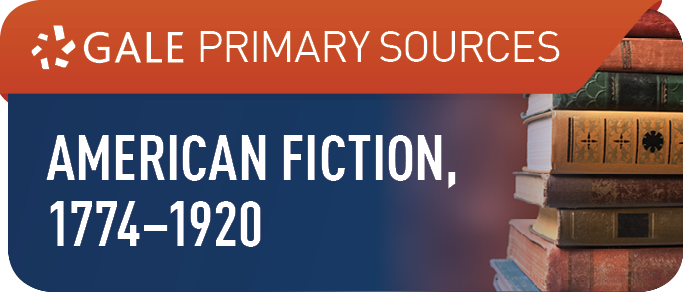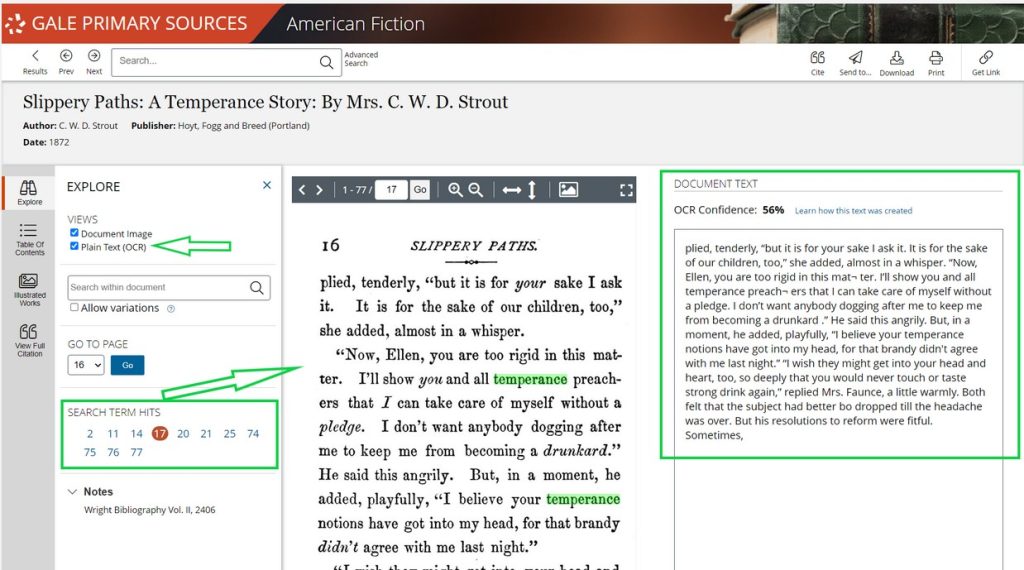
Embark on a literary journey through the epochs of American history with American Fiction, 1774–1920. This resource encompasses more than 17,800 works of prose fiction written by Americans from the political beginnings of the United States through World War I, including thousands never before available online. This landmark digital collection is based on authoritative bibliographies including thousands never before available online.
The researcher can explore the development of American literature through novels, short stories, romances, fictitious biographies, travel accounts, and sketches. Revealing the socioeconomic, political, and religious tenor of America through this time period allows students and researchers “to answer key questions about history, society, identity, psychology, race, gender, and culture.”
The collection comes from three major sources. First, nearly all the works found in Lyle H. Wright’s American Fiction: A Contribution Toward a Bibliography. This three-volume set consists of: American Fiction, 1774–1850; American Fiction, 1851–1875; and American Fiction, 1876–1900. The second major source is the titles published from 1901 to 1910 which were gathered from major American fiction collections across the United States. Third, titles published between 1911 and 1920 come from the William Charvat Collection of American Fiction at The Ohio State University Libraries.
Wright’s criteria was to include only first editions (or the earliest copy of a work) of novels and short story collections. He excluded such items as annuals, anthologies, and collections of anecdotes. The researcher should note that although Wright sought to include only fictitious works, some slave narratives as Solomon Northup’s Twelve Years a Slave (1853), Jermain Wesley Loguen’s The Rev. J. W. Loguen, as a Slave and as a Freeman, a Narrative of Real Life (1859), and Harriet Jacobs’s Incidents in the Life of a Slave Girl (1861), are include in the database.

Search Options
The researcher can search by the entire document, keyword, document title, author, publisher, place of publication, front matter, image caption, illustrator, and Gale document number. In addition to straight search inquiries, there are two search tools that allow the researcher to explore the collection. First, the Topic Finder allows the researcher to find new topics or keywords and discover new connections found in the top results. Second, the Term Frequency tool can explore the coverage of search terms graphed over time and illuminate trends in coverage of multiple topics.
The platform allows the researcher to see the search term present in a number of works including how often and exactly where in a particular work (see image). A great feature of the platform is the OCR confidence reading. The researcher can see the original text and how accurately it has been read by optical character recognition. A ‘dirty’ OCR document may need to be manually reviewed before further searching and text analysis can be performed.
Teaching with American Fiction, 1774-1920
One of the nice options of American Fiction, 1774-1920 is the ability to perform a deep analysis of a particular author. James Fenimore Cooper was the first major American author to garner an international audience extolling American frontier life. His early works–The Pioneers, The Last of the Mohicans, and The Prairie (published between 1823 and 1827)–delve into the hardships of the early pioneers in New York State and the encroachment on Native American life. One can use the Topic Finder and Term Frequency research tools to explore the texts. Next, using a particular topic or term, one could contrast these early works with his later works–The Pathfinder (1840) and The Deerslayer (1841)–to see not only how Native life changed but also Cooper’s evolving social commentary. For a deeper analysis of the texts, these works could be collected into a dataset for further analysis in the Gale Digital Scholar Lab. The image below represents a topic modeling search on Cooper’s works.

Text Analysis
Since American Fiction, 1774-1920 is part of the Gale Digital Scholar Lab, the researcher can do a textual analysis of the entire database or build a subset of documents. Once logged in (or having created an account) in the Lab, select the ‘Build’ option (top right hand corner of the screen). Select ‘view all limiters in Advanced Search’ option. A list of available databases is given (select American Fiction, 1774-1920). While the search interface for both the Gale Primary Sources and the Gale Digital Scholar Lab are the same, the Lab allows the researcher to customize one’s own unique dataset by pulling material from Gale Primary Sources or by importing external documents from other full text databases. In addition to building individualized datasets, the Lab has six text analysis tools for examining the content further: Ngrams, Parts of Speech, Document Clustering, Named Entity Recognition, Topic Modeling, and Sentiment Analysis.
